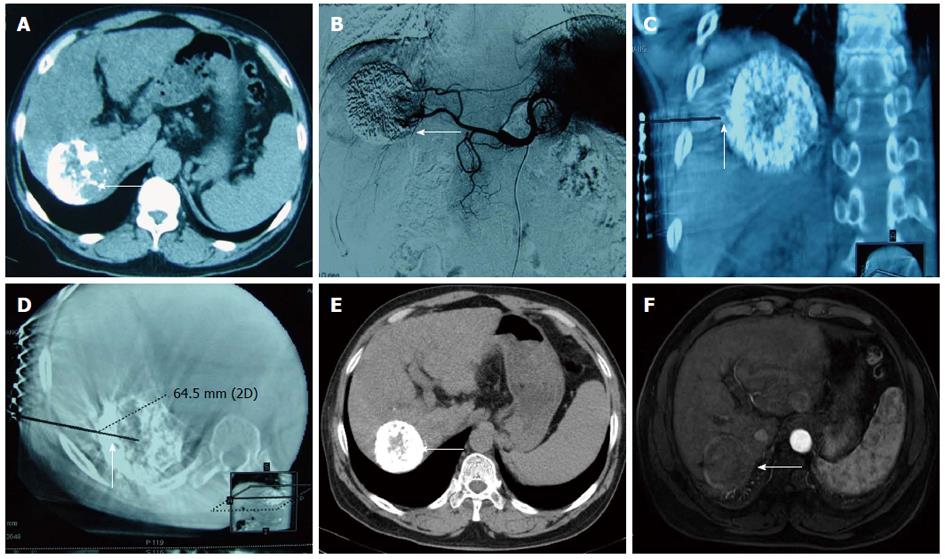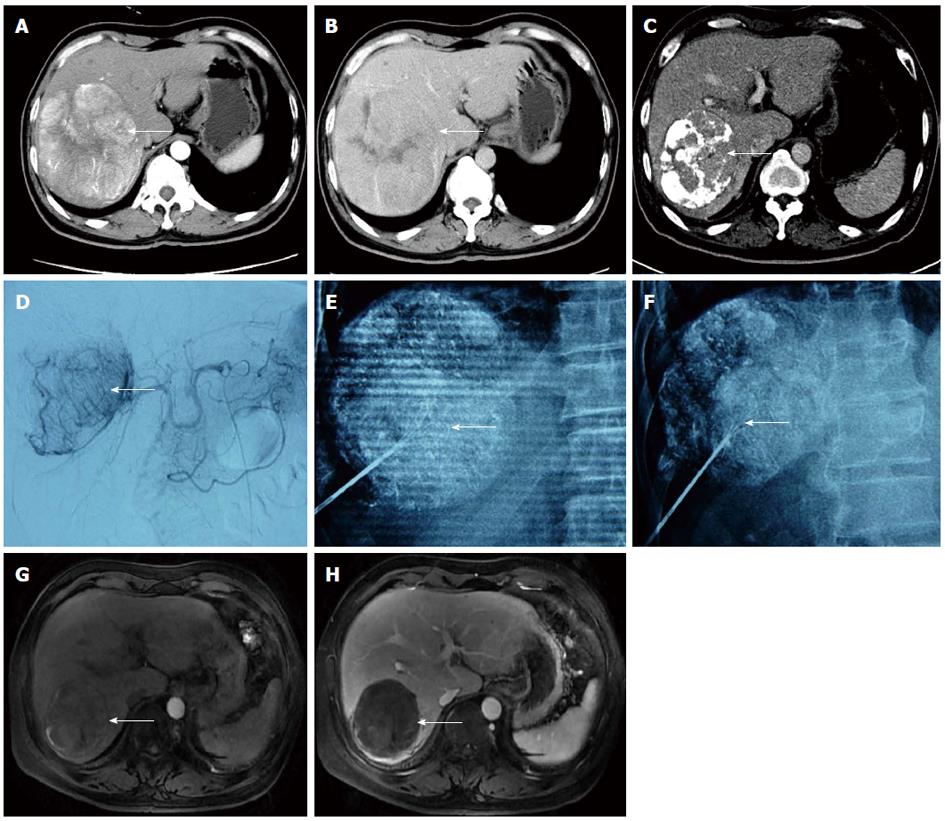Copyright
©2013 Baishideng Publishing Group Co.
World J Gastroenterol. Jul 14, 2013; 19(26): 4192-4199
Published online Jul 14, 2013. doi: 10.3748/wjg.v19.i26.4192
Published online Jul 14, 2013. doi: 10.3748/wjg.v19.i26.4192
Figure 1 A male patient aged 60 years with hepatocellular carcinoma.
Computed tomography (CT) scan showed a residual lesion in the liver after the first interventional therapy. Thus, transcatheter arterial chemoembolisation (TACE) immediately followed by radiofrequency ablation (RFA) was performed under the guidance of digital subtraction angiography (DSA)-CT. A: Liver CT scan showed a partial lipiodol deposit (arrow) after first interventional therapy; B: Angiogram performed before RFA showed a lipiodol deposit in the liver and staining of the delay phase around the lipiodol (arrow); C, D: INNOVA4100 IQ DSA-CT was used to obtain the coronal section and cross section of the reconstructed image to design the puncture path and angle (arrow); E, F: Liver CT scan 23 mo after combination therapy showed good lipiodol deposits without enhancement (arrow).
Figure 2 A male patient aged 42 years with poorly differentiated hepatocellular carcinoma.
Computed tomography (CT) scan showed a residual lesion in the liver after first interventional therapy with α-fetoprotein (345 μg/mL). Thus, transcatheter arterial chemoembolisation combined with radiofrequency ablation (RFA) was performed. A: CT scan showed a large solitary tumor in the right hepatic lobe before interventional therapy (arrow); B: A lipiodol deposit appeared around the liver tumour after the first procedure. CT revealed an enhanced residual lesion in the artery phase (arrow); C: Hepatic artery angiogram before RFA showed staining of the residual lesion around the lipiodol in the liver (arrow); D, E: A multipolar probe with a maximum extended diameter of 5 cm, which could cover the residual lesion, was designed to perform RFA in the region labelled by lipiodol and the original lesion (lipiodol deposition area). A diaphragmatic dome was involved, and the puncture tunnel detoured the lung tissue under the fluoroscope (arrow); F, G: The hepatic lesion was well controlled, and no recurrence was found after 15 mo follow-up (arrow).
Figure 3 A male patient aged 53 years with a large lesion in the right lobe of the liver.
A residual lesion was found after three cycles of transcatheter arterial chemoembolisation (TACE). TACE combined with radiofrequency ablation (RFA) was performed under the guidance of digital subtraction angiography-computed tomography. A, B: A large hypervascular hepatocellular carcinomas was observed in the right lobe (arrow); C, D: A residual lesion around the lipiodol deposit was still visible after three cycles of TACE (arrow); E, F: The lesion was successfully labelled after TACE. A multipolar needle was opened and rotated 70° to the left (E) and right (F) sides to verify whether the RF needle was in the center of the residual lesion (arrow); G, H: The large lesion was well controlled, and no recurrence was observed by magnetic resonance imaging during 13 mo follow-up after combination therapy (arrow).
- Citation: Wang ZJ, Wang MQ, Duan F, Song P, Liu FY, Chang ZF, Wang Y, Yan JY, Li K. Transcatheter arterial chemoembolization followed by immediate radiofrequency ablation for large solitary hepatocellular carcinomas. World J Gastroenterol 2013; 19(26): 4192-4199
- URL: https://www.wjgnet.com/1007-9327/full/v19/i26/4192.htm
- DOI: https://dx.doi.org/10.3748/wjg.v19.i26.4192











